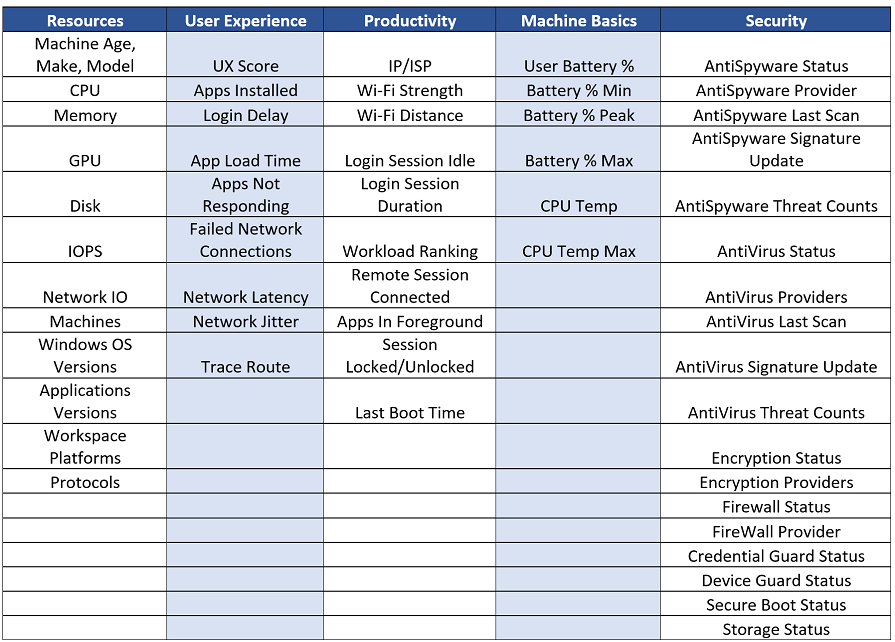With the release of Stratusphere UX v. 6.5 this week, we are proud to announce that our solution is currently the only certified end user experience monitoring solution to provide visibility into all three major cloud platforms, including Amazon Web Services (AWS) Digital Workplace Competency status, advanced monitoring for the Google Cloud Platform and detailed metrics for WVD on the Microsoft Azure Marketplace.
The Importance of Cloud

Cloud platforms to support digital workspace transformation is increasingly important at a growing numbers of enterprise organizations. Cloud platforms enable uncoupling workers from static devices, thereby letting their workspaces “roam” as needed.Â
They can perform their jobs anytime, anywhere, on any device with an Internet connection. This approach has become a paramount consideration during the pandemic, which is pushing more businesses to provide Work from Home options.
Moving desktops to the cloud provides many major benefits, including cost savings and security which make them the preferred choice. Cloud provides the best option for businesses with fluctuating workloads since this infrastructure can scale based on demand. Companies no longer need to anticipate, procure, and manage fleets of individual devices that they may or may not require, because they can pay- as-you-go. Cloud providers also offer specific prebuilt tools and features so business can customize solutions and ensure that all their workers — task, knowledge and power – can get the level of resources they need and are not limited by “what comes in the box.”
Shifting to cloud platforms also enhance security as cloud providers adhere to the best and latest security standards and procedures to protect their clients’ data saved in the cloud.
Business have the flexibility to select from private cloud, public cloud, and hybrid- cloud solutions, each with different features or go with SaaS, PaaS, and IaaS, if they better meet their needs.
Finally, being in the cloud provides all sizes of business — small, medium, and even large enterprises – with a more efficient and reliable way to backup and restore their data and applications.
The Significance of Visibility into the Cloud
While cloud platforms can bring many benefits to organizations, it may be difficult to realize these benefits unless the migration path to is clear and straightforward. When you move to the cloud, you are flying blind unless you have a means of gaining deep visibility into the infrastructure.In fact, having visibility into your own current legacy environments is a must —  even before you migrate desktop workloads to the cloud.  This visibility must provide data that can answer a number of questions, including:
- How do I define my desktop image for the specific users I wish to migrate?
- Which applications are critical? Which OS should be the standard?
- What work mode are my users in – remote, mobile, field, or static?
- Are my users task, power, or knowledge workers?
- What compute resources are required to ensure optimal user experience? How do I allocate adequate CPU, RAM, GPU, Disk?
- What are the devices/ ISPs my users will use? How well are they set up to enhance performance or are there problems with jitter, latency which are degrading user experience?
- How can I monitor the productivity of my users when they are in the cloud?
- How can I get a baseline for desktop performance in order to determine which cloud and which tier I should pursue?
Because the cloud provider controls and manages critical parts of the infrastructure, the end-customer can lose control over these aspects. Any administrator must know which OS and applications (type and version) are being used, who is using them, and what data is being generated and shared. You also must ensure your users are not installing unauthorized applications.
Performance optimization is another concern. Ensuring app and workloads are optimized is more difficult in cloud environments due to possible latency of lower speed Internet or WAN links. One needs to ensure that operating systems, databases, applications, and workloads be operating at peak performance to make up the difference. But knowing which components are sub-par and how to tune them is challenging unless you have visibility into how they are performing.
Stratusphere UX is Tailored for Onboarding Customers to Cloud Environments.
Right out of the box, Stratusphere UX assembles the critical metrics needed to allow users to assess their legacy workspaces as a baseline to determine the best cloud provider and best tier to support their workloads.
Once the correct cloud bundle is selected, and workloads are moved to the cloud, Stratusphere UX can then be used to create “before and after” validation to prove workspaces are performing to SLAs.
The solution gathers and provides key user experience metrics to support design of desktop images and infrastructure for all major cloud providers including Amazon Web Services, Google Cloud and Microsoft Azure. Key diagnostics ensure that the highest fidelity desktops are provided to users based on their requirements, whether routine task, or more complex knowledge or power users.
The solution offers the following user-experience-based metrics to provide decision support for starting, fine-tuning and scaling cloud implementations.
- Easy to use and understand template selection reports for SLA validations
- A UX score to highlight Good, Fair or Poor candidates for a cloud platform
- Resource metrics, including CPU, RAM, GPU, disk and more
- Detailed “in-session” performance visibility metrics by group or user
- Comprehensive time-based drill-down diagnostic metrics for quick problem-resolution and for deep forensic analysis.
- Performance metrics and diagnostics for related storage, network, protocols, and application servers.
- First mile metrics for local ISPs and user devices to monitor effectiveness of “at home” technology and productivity of workers
- Includes API for alerts, traps, and integration with other monitoring solutions
- Process optimization feature to yield greater user and workload density on shared platforms by prioritizing foreground processes for resources.
Stratusphere UX Provides Essential Work-From-Home Metrics
Cloud has become the platform of choice to roll out urgent Work-From-Home (WFH) strategies amid the current pandemic situation. Stratusphere UX has an extensive collection of WFH metrics that are essential to analyzing the performance of cloud desktop users and ensuring they are productive and secure. With 6.5, Liquidware has added a new category called Machine Health for Windows desktops. Within this category, we have broken out metrics for Machine Basics and for Security. The table below outlines essential WFH metrics provided in Stratusphere UX.

Certified Solution on Leading Cloud Provider Marketplaces
Liquidware’s Stratusphere UX is the industry-leading user experience monitoring and diagnostics solution. The solution captures patented, unique metrics found only in this product, that covers the desktop environment from end-point devices to the cloud. This solution has been recognized by leading cloud platforms as strategic to implementing desktop workloads. Stratusphere UX is listed as a certified solution on the following cloud provider marketplaces:
The solution has achieved Amazon Web Services (AWS) Digital Workplace Competency status.
The solutions provides advanced monitoring for the Google Cloud Platform.
The solution provides detailed metrics for WVD and is listed on the Microsoft Azure Marketplace.








Leave A Comment
You must be logged in to post a comment.